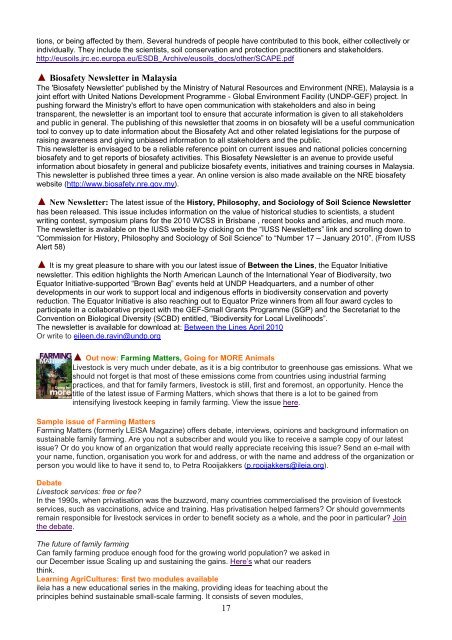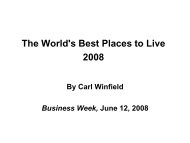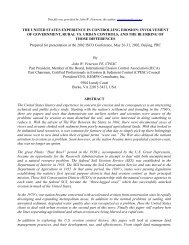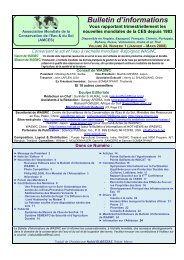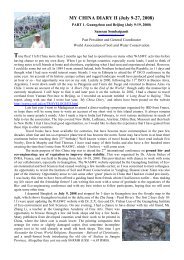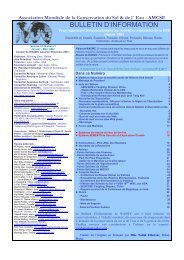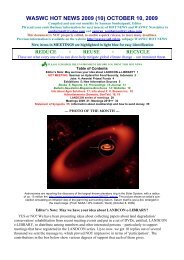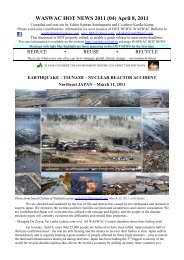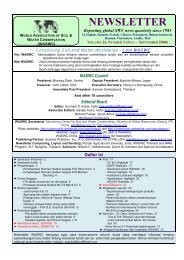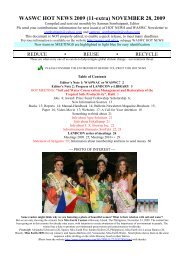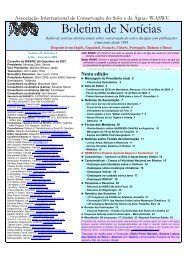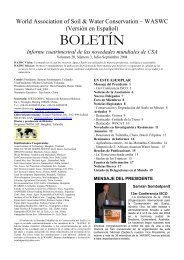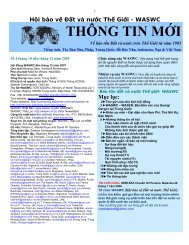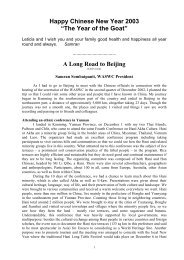April 30, 2010 - World Association of Soil and Water Conservation
April 30, 2010 - World Association of Soil and Water Conservation
April 30, 2010 - World Association of Soil and Water Conservation
Create successful ePaper yourself
Turn your PDF publications into a flip-book with our unique Google optimized e-Paper software.
tions, or being affected by them. Several hundreds <strong>of</strong> people have contributed to this book, either collectively orindividually. They include the scientists, soil conservation <strong>and</strong> protection practitioners <strong>and</strong> stakeholders.http://eusoils.jrc.ec.europa.eu/ESDB_Archive/eusoils_docs/other/SCAPE.pdf▲ Biosafety Newsletter in MalaysiaThe 'Biosafety Newsletter' published by the Ministry <strong>of</strong> Natural Resources <strong>and</strong> Environment (NRE), Malaysia is ajoint effort with United Nations Development Programme - Global Environment Facility (UNDP-GEF) project. Inpushing forward the Ministry's effort to have open communication with stakeholders <strong>and</strong> also in beingtransparent, the newsletter is an important tool to ensure that accurate information is given to all stakeholders<strong>and</strong> public in general. The publishing <strong>of</strong> this newsletter that zooms in on biosafety will be a useful communicationtool to convey up to date information about the Biosafety Act <strong>and</strong> other related legislations for the purpose <strong>of</strong>raising awareness <strong>and</strong> giving unbiased information to all stakeholders <strong>and</strong> the public.This newsletter is envisaged to be a reliable reference point on current issues <strong>and</strong> national policies concerningbiosafety <strong>and</strong> to get reports <strong>of</strong> biosafety activities. This Biosafety Newsletter is an avenue to provide usefulinformation about biosafety in general <strong>and</strong> publicize biosafety events, initiatives <strong>and</strong> training courses in Malaysia.This newsletter is published three times a year. An online version is also made available on the NRE biosafetywebsite (http://www.biosafety.nre.gov.my).▲ New Newsletter: The latest issue <strong>of</strong> the History, Philosophy, <strong>and</strong> Sociology <strong>of</strong> <strong>Soil</strong> Science Newsletterhas been released. This issue includes information on the value <strong>of</strong> historical studies to scientists, a studentwriting contest, symposium plans for the <strong>2010</strong> WCSS in Brisbane , recent books <strong>and</strong> articles, <strong>and</strong> much more.The newsletter is available on the IUSS website by clicking on the “IUSS Newsletters” link <strong>and</strong> scrolling down to“Commission for History, Philosophy <strong>and</strong> Sociology <strong>of</strong> <strong>Soil</strong> Science” to “Number 17 – January <strong>2010</strong>”. (From IUSSAlert 58)▲ It is my great pleasure to share with you our latest issue <strong>of</strong> Between the Lines, the Equator Initiativenewsletter. This edition highlights the North American Launch <strong>of</strong> the International Year <strong>of</strong> Biodiversity, twoEquator Initiative-supported “Brown Bag” events held at UNDP Headquarters, <strong>and</strong> a number <strong>of</strong> otherdevelopments in our work to support local <strong>and</strong> indigenous efforts in biodiversity conservation <strong>and</strong> povertyreduction. The Equator Initiative is also reaching out to Equator Prize winners from all four award cycles toparticipate in a collaborative project with the GEF-Small Grants Programme (SGP) <strong>and</strong> the Secretariat to theConvention on Biological Diversity (SCBD) entitled, “Biodiversity for Local Livelihoods”.The newsletter is available for download at: Between the Lines <strong>April</strong> <strong>2010</strong>Or write to eileen.de.ravin@undp.org▲ Out now: Farming Matters, Going for MORE AnimalsLivestock is very much under debate, as it is a big contributor to greenhouse gas emissions. What weshould not forget is that most <strong>of</strong> these emissions come from countries using industrial farmingpractices, <strong>and</strong> that for family farmers, livestock is still, first <strong>and</strong> foremost, an opportunity. Hence thetitle <strong>of</strong> the latest issue <strong>of</strong> Farming Matters, which shows that there is a lot to be gained fromintensifying livestock keeping in family farming. View the issue here.Sample issue <strong>of</strong> Farming MattersFarming Matters (formerly LEISA Magazine) <strong>of</strong>fers debate, interviews, opinions <strong>and</strong> background information onsustainable family farming. Are you not a subscriber <strong>and</strong> would you like to receive a sample copy <strong>of</strong> our latestissue? Or do you know <strong>of</strong> an organization that would really appreciate receiving this issue? Send an e-mail withyour name, function, organisation you work for <strong>and</strong> address, or with the name <strong>and</strong> address <strong>of</strong> the organization orperson you would like to have it send to, to Petra Rooijakkers (p.rooijakkers@ileia.org).DebateLivestock services: free or fee?In the 1990s, when privatisation was the buzzword, many countries commercialised the provision <strong>of</strong> livestockservices, such as vaccinations, advice <strong>and</strong> training. Has privatisation helped farmers? Or should governmentsremain responsible for livestock services in order to benefit society as a whole, <strong>and</strong> the poor in particular? Jointhe debate.The future <strong>of</strong> family farmingCan family farming produce enough food for the growing world population? we asked inour December issue Scaling up <strong>and</strong> sustaining the gains. Here’s what our readersthink.Learning AgriCultures: first two modules availableileia has a new educational series in the making, providing ideas for teaching about theprinciples behind sustainable small-scale farming. It consists <strong>of</strong> seven modules,17


